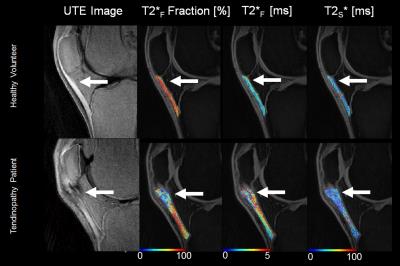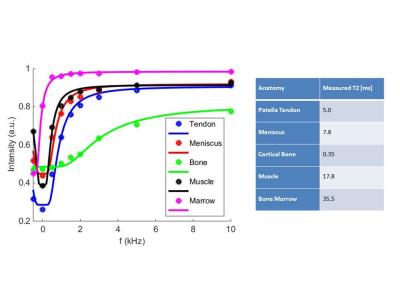Tuesday, 25 April 2017
| Room 311 |
08:15 - 10:15 |
Moderators: Ashley Williams, Martijn Froeling |
Slack Channel: #s_msk
Session Number: O36
08:15
|
0372.
 |
7T Diffusion Tensor Imaging of High Mechanical Stress Achilles Tendon-to-Bone Interface - video not available
Simone Angela Winkler, Lara Kuntz, Christoph Leuze, Hossein Nejadnik, Laura Pisani, Heike Daldrup-Link
We present imaging analysis using MRI of the Achilles tendon-to-bone interface (“enthesis”) to investigate on the four distinct zones responsible for mechanical force transfer. Conventional T1- and T2-weighted imaging in humans yields very low MR signal. We therefore present T1-weighted FLASH 3D imaging at ultra high-field (7T), using a porcine sample from a minipig leg. We were able to identify the four zones (fibrous connective tissue, uncalcified fibrocartilage, calcified fibrocartilage, and bone) in both T1 and diffusion tensor imaging (DTI).
|
08:27
|
0373.
 |
3D UTE-T2* analysis of diseased Achilles tendons and the correlation with clinical score - video not available
Yang Qiao, Hong-Yue Tao, Yi-Wen Hu, Jianxun Qu, Kui Ma, Zi-Ying Wu, Shuang Chen
This study used 3D UTE-T2*, a novel quantitative technique with potential short-T2* relaxations to investigate T2* value in diseased Achilles tendon(AT) and correlation between T2* value and AOFAS, ATRS scores. Fifteen patients with AT disease and ten healthy controls matched sex, age, BMI were included. The results showed T2* values of insertion(INS), middle(MID), muscle-tendon junction(MTJ) and bulk region of AT in patients were statistically higher than healthy controls and negatively correlated with AOFAS, ATRS scores, which suggests UTE-T2* may be a promising marker for the detection of matrix changes in AT and give a precise guidance to clinical outcome.
|
08:39
|
0374.
 |
Difference Image Ultra-Short Echo Time T2* Mapping Using a 3D Cones Trajectory 
Amin Nazaran, Grayson Tarbox, Randy Hartley, Neal Bangerter
This study introduces a methodology for detecting subtle variations in tissues with very rapid T2* decay through a difference image ultra-short T2* mapping technique using a 3D cones k-space trajectory. The new method is demonstrated in both a normal and surgically repaired Achilles tendon. The resulting UTE images were differenced and T2* values were calculated using a mono-exponential least squares fit on a voxel by voxel basis. The ultrashort T2* maps yield very consistent short T2* values in healthy tendon of 0.3 – 0.5 ms, while notable variations and elevations of T2* values are observed in the surgically repaired tendon.
|
08:51
|
0375.
 |
Bi-Component Ultra-short Echo-Time T2* Analysis in Patients with Patellar Tendinopathy 
Fang Liu, John Wilson, Richard Kijowski
A bi-component ultra-short echo-time (UTE) T2* mapping sequence was performed on the knees of 10 patients with patellar tendinopathy and 10 healthy volunteers at 3T. The fraction of the fast relaxing water component (FF) and the T2 relaxation times of the fast relaxing (T2*F,) and slow relaxing (T2*S) water components of patellar tendon were measured. Patients with patellar tendinopathy had significantly lower FF (P=0.007), significantly higher T2*F (P=0.014), and similar T2*S (P=0.10) of patellar tendon when compared to healthy volunteers. Our results suggest that bi-component UTE T2* analysis can detect early compositional and microstructural changes in degenerative tendon.
|
09:03
|
0376.
 |
Rotator Cuff Tendon Assessment Using Magic-Angle Insensitive 3D Ultrashort Echo Time Cones Magnetization Transfer (UTE-Cones-MT) Imaging and Modeling - permission withheld
Yanchun Zhu, Yajun Ma, Jiang Du, Eric Chang
The rotator cuff tendon (RCT) is the primary dynamic stabilizer of the glenohumeral joint. However magic angle effect decrease the sensitivity of MRI in assessment of RCT. The purpose of our study is to utilize the 3D ultrashort echo time Cones sequence with magnetization transfer preparation (UTE-Cones-MT) and two-pool quantitative MT modeling to assess the RCT.
|
09:15
|
0377.
 |
Diffusion Tensor Imaging of the Anterior Cruciate Ligament Graft 
Pieter Van Dyck, Eline De Smet, Martijn Froeling, Peter Verdonk, MichaŽl Torfs, Pim Pullens, Jan Sijbers, Paul Parizel, Ben Jeurissen
Anterior cruciate ligament (ACL) reconstruction using a tendon graft remains the standard of care for ACL injuries. Postoperatively, the graft undergoes a biologic transition from tendinous to ligamentous in appearance. Despite substantial research efforts, little is known about the human ACL graft ligamentization process. Much of the current knowledge on graft ligamentization have been derived from biopsy studies. However, biopsies are invasive and suffer from sampling error. Our study demonstrates the feasibility and reliability of diffusion tensor imaging (DTI) for visualization and quantification of the ACL graft and supports its potential to serve as a biomarker to assess graft maturity.
|
09:27
|
0378.
 |
Advances in Angle Sensitive MRI: Towards in vivo analysis of collagen fibre tracts in the Anterior Cruciate Ligament 
Karyn Chappell, Quentin Herreros, Donald McRobbie, Djordje Brujic
There is great interest in collagen MR imaging due to its non-invasive nature. To be able to detect early structural changes in collagen the main magnetic field must move around the patient. A new rotatable MR system enabling in vivo Angle Sensitive MRI was designed and its prototype has been built. Key elements of the new method are: optimisation of scanning directions, collagen orientation distribution computation and fibre tract reconstruction.
We have proved that nine scans in optimal directions achieve satisfactory accuracy. Previous Angle Sensitive MRI times are almost halved whilst analysis time is shortened by more than 100 times.
|
09:39
|
0379.
 |
Collagen fiber to magnetic field angle dependence in human meniscus – a preliminary T2* MR-microscopy study at 7T 
Benedikt Hager, Sonja Walzer, Vladimir Juras, Martin Zalaudek, Xeni Deligianni, Oliver Bieri, Andreas Berg, Joachim Friske, Markus Schreiner, Reinhard Windhager, Siegfried Trattnig
We evaluated the fiber-to-field dependence of a meniscal specimen using T2* mapping on high-field 7T MRI in combination with an MR microimaging insert and validated the results with histology. We found that, different structures of the meniscus behave very differently with orientation to the magnetic field. For example, short T2/T2* tendon-like structure located in the external circumference showed strongest T2* dependence reflecting the anisotropic nature of these structures and consequential incomplete averaging of dipolar coupling. The results shown here are the first MR Microscopy evaluations of the orientational dependence of T2* relaxation in human meniscus.
|
09:51
|
0380.
 |
The magic angle effect can (partially) explain load-induced increases in meniscal T2 and T1? 
Valentina Mazzoli, Danny Tsui, Larry de Graaf, Klaas Nicolay, Andre Sprengers, Dennis Janssen, Nico Verdonschot, Aart Nederveen, Gustav Strijkers
Often, knee injury and disorders are caused by or lead to abnormal biomechanical loading patterns in the knee joint menisci. Quantitative information on in vivo loading patterns is therefore in high demand to evaluate therapy and prevent further damage. T1ρ and T2 in meniscus were shown to increase upon application of compressive load, although the mechanisms leading to changes remain unclear. In this work we apply compressive load on the meniscus of volunteers and one cadaver and show that compression-induced internal fiber reorganization may manifest as the magic angle effect, which may be responsible for load-induced T2 and T1ρ increases.
|
10:03
|
0381.
 |
Quantitative Off Resonance Saturation 3D UTE Imaging 
Michael Carl, Yajun Ma, Jiang Du
Off-resonance saturation (ORS) is a tool which can be used in UTE magnetic resonance imaging to selectively reduce short T2 signals. Here we develop a simple quantitative theoretical model. The theoretical equations can be used to determine the ORS sequence parameters such as foff and θORS to maximize short T2 contrast.
|
|










